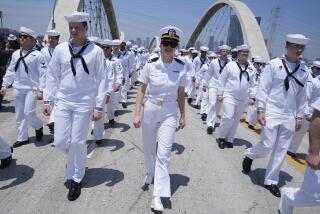Marine D.I.s Give an Earful to Soviet Brass
- Share via
Marine Corps drill instructor Dave Brown faced the high-ranking Soviet navy officers and screamed at the top of his lungs: “Keep your mouths closed!”
Startled, Soviet Commander of the Pacific Fleet Adm. Genadiy Alexandrovich Khvatov looked at Staff Sgt. Brown and raised his bushy eyebrows.
“Keep your head and eyeballs straight!” barked Brown, who teaches people how to stand at attention--one way or another. “Hurry up. Hurry up. Get out of the way.”
Welcome to Marine Corps boot camp.
Seventeen visiting Soviet navy officials and their U.S. counterparts endured the first two minutes of boot camp at the Marine Corps Recruit Depot Thursday with good grace as Brown and other D.I.s screamed at them to put their feet on the yellow footprints that forced them to line up in platoon-like fashion. It didn’t cause an international incident.
U.S. officers explained to the Soviets that fierce yelling is the standard introduction to boot camp and is the best way to prove that the civilian world disappeared when the recruits passed through the depot’s gates. But, from the looks on the dignitaries’ faces, clearly there is no way to prepare anyone for his first face-to-face encounter with a Marine D.I.
Asked if anything in the two days of picnics, sightseeing, and tours of naval facilities had surprised him, Rear Adm. Igor N. Khmel’nov replied: “The two minute stand-at-attention drill.”
The Soviet officers are among the 850 who sailed here aboard three Soviet navy ships Tuesday in the first such visit to the West Coast in 127 years. It represents the second round of a navy-to-navy exchange program that began last year when Soviet ships made a port call at Norfolk, Va., and the U.S. Navy sailed to the Black Sea port of Sevastopol. Next month, U.S. warships will sail to Vladivostok.
On Saturday, the Soviets will depart San Diego, where Soviet vessels have traditionally been prohibited from visiting because it is considered a hub of U.S. Navy activity.
“It is unheard of, Soviet warships in San Diego,” said Col. Regan R. Wright, chief of staff at the Recruit Depot next to Lindbergh Field. “Two years ago, it would have been World War III if they tried to pull in.”
The port call, meant to further goodwill and friendship between the two nations, has been hailed by both Soviets and Americans as a success.
“The visit has exceeded our expectations,” said Adm. Charles Larson, commander-in-chief of the U.S. Pacific Fleet. “We probably won’t agree on everything, but it’s important that we understand each other and find a common ground.”
Larson accompanied Khvatov and a slew of navy brass from both countries over the dusty Marine training ground Thursday morning. On the obstacle course, several hundred camouflage-clad recruits ran, climbed up ropes, scrambled down wires, rappelled off walls, tumbled into ditches, vaulted hurdles, leaped over poles, and sweated.
Khvatov at one point waved over 18-year-old Pvt. Frederick Johnson, an 18-year-old recruit from St. Petersburg, Fla. Through an interpreter, Khvatov asked what brought the young man here.
“I want to serve my country, sir,” Johnson hastily replied.
Khvatov wished Johnson good luck, then walked to a platform holding barbells. He flexed his muscles and picked up a 25-pound set.
The party then moved to a jousting exercise dubbed “Bridge over Troubled Water,” where two recruits on a narrow footbridge were pummeling one another with pugil sticks.
“Why are you dancing up there?” one drill instructor screamed as the men whacked at each other with the padded sticks. As one man tumbled from the bridge into the water, Khvatov questioned Sgt. Rodney Mitchell about the exercise. Mitchell explained that it helped teach the basics of fighting with bayonets.
When Khvatov walked off, Mitchell--a man whose biceps are larger than cantaloupes--was clearly awed. “I didn’t think I would ever have a chance to talk to a Soviet admiral like that,” said Mitchell, a 28-year-old Birmingham, Ala. native.
But, for the Soviet officers, the visit was more than just watching and getting yelled at by drill instructors. They were also required to participate.
Maj. Gen. John S. Grinalds, commander of the Marine Corps’ western recruiting region, taught the Soviet guests to slap the high-five salute and to bellow the guttural Marine cry: “Ooh-rah.”
The trademark “Ooh-rah” sound is “the only way recruits can express emotion,” explained Grinalds, who led the guests in three choruses.
“It’s been more than 100 years since the Soviet navy visited San Diego--that is too long,” said Grinalds. “You must come back sooner.”
Soviet Vistors’ Itinerary
TODAY
10 a.m.: Soviet sailors visit Miramar Naval Air Station.
11:30 a.m.: Senior U.S and Soviet naval officers address graduating class at Fleet Training Center.
Noon: Soviet song-and-dance troupe performs at Balboa Park Organ Pavilion, public welcome.
Noon to 6:30 p.m.: Public visits U.S. and Soviet ships, tickets are required.
12:45 p.m.: Soviet sailors visit Camp Pendleton, where they eat barbecue and watch U.S. Marines put on a rodeo.
7:30 p.m.: Soviet song-and-dance troupe performs at Tidelands Park in Coronado, public welcome.
SATURDAY
9:30 a.m.: Departure Ceremony at Pier 2.
10:15 a.m.: Soviet ships leave.
More to Read
Sign up for Essential California
The most important California stories and recommendations in your inbox every morning.
You may occasionally receive promotional content from the Los Angeles Times.













